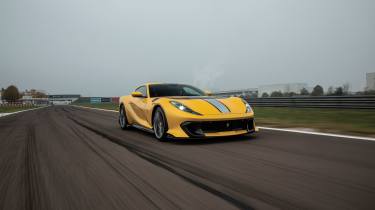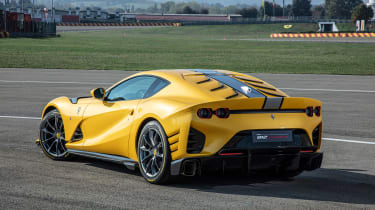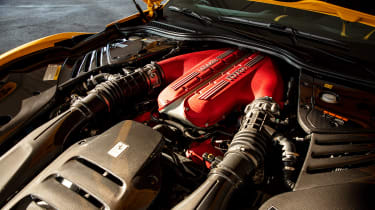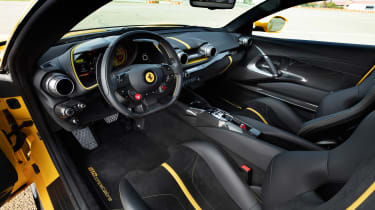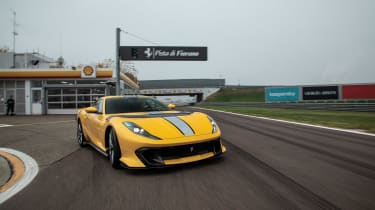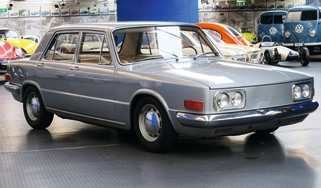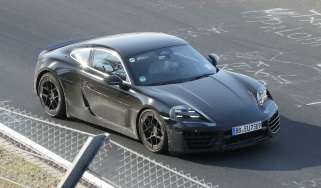Ferrari 812 Competizione 2021 review – a front-engined V12 crescendo
The Ferrari 812 Competizione doesn’t just thrill on account of its staggering engine, but also its engaging and approachable chassis
The most powerful purely petrol-powered road car engine Ferrari has ever made; a naturally aspirated V12, revving to 9,500rpm, that produces 819bhp. Yes, the numbers alone are enough to be wowed by Ferrari’s new 812 Competizione, the latest special series Ferrari at the top of the V12 range – a car that follows in the illustrious tyre tracks of the F12TdF and the 599 GTO, and if you look further back, the original GTO and 250 GT SWB from the 1960s. Those are quite some cars to live up to, but then Ferrari has been busy creating more than just an outstanding engine to turn the 812 Superfast into the Competizione.
Nevertheless, starting with the engine feels as good as any place to begin. The F140 series V12 with its 65-degree V angle, first seen in the Enzo, retains its 6.5-litre capacity from the Superfast. However, to create this ‘HB’ variant there’s much that has been changed: the block now features rods made from titanium (40 percent lighter), and pistons coated in a low friction DLC (diamond-like coating) compound. There is a heavily revised cylinder head, with sliding finger cam followers to permit a 500rpm higher rev limit, and a completely new intake system with a compact plenum but variable length inlet tracts to maintain low end torque.
The result is 30bhp more than the Superfast’s ‘F140 GA’ engine at 819bhp, which from a fully homologated road car seems like a slightly surreal amount of power to extract from such an engine, unless of course, your name is Cosworth. The sacrifice has been a small reduction in torque from the 812 Superfast’s 530lb ft back down to 510lb ft. Interestingly, that’s virtually identical to the old F12, released in 2012, which proves you can chase power and revs, but finding substantially more torque from an already highly tuned naturally aspirated engine is altogether a different matter.
More reviews
It’s connected to a revised seven-speed twin clutch gearbox, and exhales through a new exhaust system that fans out wide to enable a large rear diffuser, and exits through characteristic rectangular ends that are the actual climax of the system, not exhaust trims. It must be the first time in decades a Ferrari hasn’t had the modern conceit of exhaust ‘finishers’.
You can read more about the technical makeup of the Competizione here, but between the work of Ferrari’s aerodynamics and its internal Centro Stile department the Competizione looks shorter, wider and more menacing than the regular Superfast. The passing air is carefully managed all around the car, standout features being the blade that runs across the bonnet, allowing air from various places to escape, and the large, integrated rear wing, in part enabled by no requirement for rear visibility. Instead, the rear window is a solid carbon panel, itself festooned with vortex generators, and a rear camera system provides visibility of those behind. The underside of the car is especially flat, and a peer underneath proves that the rear diffuser is a very serious device indeed.
> Click here for our review of the Lamborghini Aventador SVJ
Neither have the electronics been ignored, with amongst other things the introduction of Virtual Wheelbase 3.0. Not only is there rear-wheel steering, but now each rear wheel can steer independently of the other thanks to an actuator on each wheel. When accelerating hard on a straight the rears will toe out to reduce tyre drag. When braking hard, the rears will toe in to aid stability. Taking a slow speed right hand corner? Then the outer wheel will toe in more than the inner, not only improving the turn in, but also boosting lateral grip by preloading the outer tyre with just a little side slip so that it isn’t starting from zero grip. Switch course in, let’s say, an S bend, and the inner wheel is better aligned to make the switch to toeing in more than in a conventional rear-wheel steer car. Take a faster corner at high speed and the effect is less, boosting stability. It’s fiendishly clever stuff, but the upshot of it all is that Ferrari has felt confident moving to a 275 width front tyre in the knowledge that the rear axle has the support and behaviour to keep things under control.
Predictably there’s so much more to talk about with the 812 Competizione, but it’s time to get behind the wheel. It’s a cabin dominated by carbonfibre and Alcantara, at least on the cars we’ve seen, and the layout of TFT screens and general switchgear will be familiar to anyone who has driven a Superfast. The V12 explodes into life and feels incredibly sensitive to the throttle, while the noise is of the very serious order. Immediately it sounds more purposeful than the Superfast, although the inclusion of GPF filters means from the outside it is loud, but doesn’t dominate its surroundings.
First impressions are that the usual Ferrari methodology is present and correct. The steering is light and very fast, and the whole car feels highly strung. We’re only getting to drive it on the Fiorano circuit today, so a judgement on road manners will have to wait, but on the track there’s no time to get up to speed – it's full throttle from the start.
The V12 simply revs and revs. It takes some resolve to really keep the throttle pinned and the reward is a never ending, soaring delivery or raw power, which feels intimidating on the circuit and must be positively outrageous on the public road. The gearshifts are as slick as it’s surely possible to be, and I love the way the engine whoops on the downchange. The nose really wants to tuck into the apex as soon as you turn the wheel, and you realise that small, accurate inputs are going to be important to keep the car calm. With all that power at your disposal, it's not surprising that the rear can be unstuck very easily, but it’s also soon clear that the Competizione works in a relatively straightforward way.
Once there’s heat in the Michelin Cup 2R tyres (Pirelli Corsas are an option for road use) there’s genuine communication on offer here, even if it requires quick processing of that information if you’re to stay on top of the car. No one could ever call a 819bhp car friendly, but the Competizione doesn’t feel on a knife’s edge, instead encouraging you to use more and more of the engine’s exertions as your own confidence increases. It’s a shame the brakes feel a little hard pressed during the work out. There’s the suggestion that the carbon discs and new ‘SF90’ ducted calipers may not have been cooled properly on previous runs, but there’s a shudder and lengthening of braking distance that suggests they’re working hard to slow what is still a heavy machine (despite a 38kg weight drop over the Superfast).
Prices and rivals
Some 999 Comps will be made (with a further 599 Aperta versions), starting at £446,970, although you’ll be over half a mil easily once you’ve started ticking options boxes – and that’s if you’re granted a build slot in the first place. Yet while those figures are just more big numbers in a car that looks like it might be defined by such things, it’s actually a warm, sensuous and deeply charismatic kind of road racer that’s nothing if not phenomenally exciting.

